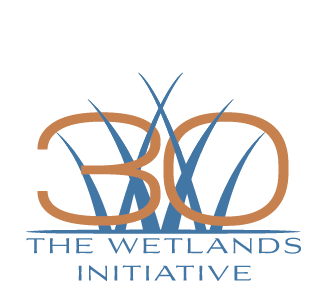And boggonit, people like me! Illinois and the rest of the U.S. Midwest were once brimming with vibrant, life-sustaining wetlands. The Wetlands Initiative restores these ecosystems where muskrats like myself and your other water-loving neighbors can thrive.
-
A semi-aquatic mammal found throughout Illinois, muskrats are often mistaken for beavers. But unlike the wide, flat tail of the beaver, the muskrat’s tail is long and thin. And while both live in lodges, muskrats build theirs out of vegetation like cattails, not wooden material like the sticks and logs beavers use.
Muskrats are wetland “engineers.” As they eat aquatic vegetation and build their houses, they naturally create openings in the water to form hemi-marsh—a type of wetland that provides critical foraging and nesting habitat for many marsh birds and other wildlife.
-
Native to Illinois, the Gray Tree Frog is one of only a handful of North American frog species that produce glycerol during hibernation to withstand below-freezing temperatures. The sweet liquid acts as a natural antifreeze in the frog’s cells.
This tree-loving frog lives in woodlands near water and is well known for changing color based on the outdoor temperature, amount of light, and other factors; its color can range from gray to brown to green at any given time.
-
Illinois is a stopover for Ruddy Ducks during the spring and fall migrations. In summer, during the breeding season, the usually dull gray bill of the male Ruddy Duck turns a bright blue. As part of its courtship display, the male beats its bill against its neck to create bubbles in the water.
While their numbers are currently stable, Ruddy Ducks are dependent on wetlands for survival. The continuing loss of habitat would put these wetland casanovas at risk.
-
All dragonflies have compound eyes covering most of their head like a motorcycle helmet, allowing them to see in virtually all directions at the same time. Blue Dashers are small compared to many other dragonfly species, but the males are among the showiest, including their blue-green eyes.
Found throughout Illinois, Blue Dashers—like all dragonflies—rely on marshes and other wetlands for breeding and survival, and their numbers are a good indicator of the health of a wetland ecosystem.
-
Many pollinator populations are declining, but Rusty Patched Bumble Bees are now so rare that they’ve been placed on the U.S. endangered species list. In recent years, they’ve been seen in Illinois at two Wetlands Initiative project sites, where healthy prairie–wetland landscapes are being restored.
Only worker bees and males, not queens, have the distinctive rusty reddish patch on their back. And unlike some pollinators, Rusty Patched Bumble Bees collect pollen and nectar from a wide variety of flowers and are not reliant on a particular plant.
Replacing the Irreplaceable
The Wetlands Initiative envisions a world with plentiful healthy wetlands improving water quality, climate, biodiversity, and human well-being.
Don’t Miss
A Beat
Wade through the wetlands
with the latest news.
Find Your
Marsh Match
Who needs eHarmony when you’ve got ecoHarmony? Take our Wetland Compatibility Quiz and discover your water-loving soulmate.
-
Not Just a Swamp
It’s exactly how it sounds: wet land. Technically, it’s part of a landscape where the presence of water influences most, if not all, of that area’s biological, physical, and chemical characteristics. The amount of water in a wetland can vary greatly, making for many types of wetlands—from bogs to marshes to wet meadows and wet prairies. Wetland habitats are teeming with all forms of life. From flying to floating. Creeping to leaping. Flowers to fungi. Micro to WHOA! A whopping number of species feed, rest, breed, and hang out in these water-rich ecosystems. Some are just passing through, while others call it home. Every season looks and feels new.
-
The Hardest-Working Ecosystem Around
Wetlands are critical for improving water quality, providing habitat for wildlife, and moderating the effects of climate change. They are beautiful places for people to hike, paddle, birdwatch, and otherwise enjoy time in the outdoors. And yet, wetlands remain one of the most threatened ecosystems in the world today.
-
Wetland restoration brings together ecology and engineering to create newly resilient ecosystems. A sustainable future is no longer possible through preservation alone. By bringing back an area’s natural water patterns, removing invasive plant species, and reintroducing native ones lost over time, we make room for wildlife to find its way back. The result is a vibrant, abundant, flourishing landscape.







